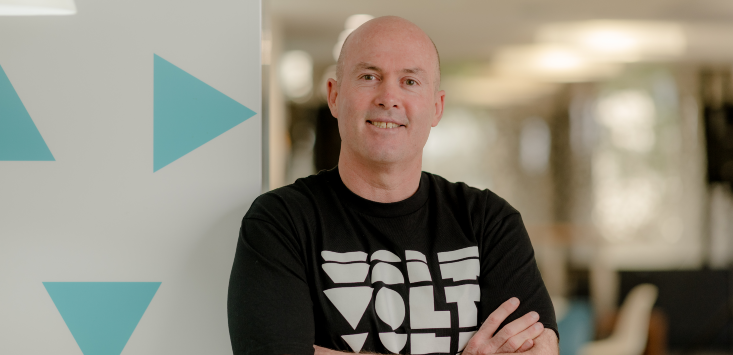
Volt co-founder and chief Steve Weston. Source: supplied.
Neobank Volt has acquired alternative lender Australian Mortgage, in a bid to bring tech into an antiquated industry, and improve efficiency for brokers and borrowers alike.
It means the bank will be able to offer a mortgage product for the first time — one it says will allow for fully verified approval times of 15 minutes or less.
Speaking to SmartCompany, Volt co-founder and chief Steve Weston says the acquisition represents a milestone for Volt.
Getting mortgage approvals is a “pain point” for Australian consumers, he notes, and can take as long as 25 days.
Reducing that waiting time to a matter of minutes is “revolutionary”, he adds.
The new offering will pair Australian Mortgage’s Intelligent Credit solution with Volt’s Banking-as-a-Service offering to bring the lending approval process into the digital era.
It combines technology with the lower cost of funding available to a bank, compared to a non-bank lender, Weston explains.
Yet, it still uses a network of brokers to source loan customers.
“From a business perspective, it makes a whole lot of sense,” Weston adds.
“For the first time we’ve seen a bank own modern mortgage technology.”
In a statement, Volt chief customer and partnerships officer Andrew Clouston said the two businesses have “rebuilt the entire process”, to create a “genuinely data-driven solution”.
Improving efficiency for brokers will give them more time to focus on customer service, he added, which “underpins the important role mortgage brokers play in every Australian’s home ownership aspirations”.
Value adds
Weston doesn’t disclose the value of the acquisition, but he does share that the majority of the purchase consideration is in Volt shares.
That’s indicative of the commercial opportunity here, he suggests. The Australian Mortgage shareholders believe this partnership will only drive Volt’s valuation up — of course, Weston agrees.
The new digital mortgage solution will be distributed through Australian Financial Group (AFG) mortgage brokers, with a pilot set to launch in the final quarter of 2021.
It is expected to become available to all of AFG’s brokers in early 2022.
In June, Volt announced it had made a strategic partnership with AFG, which also invested $15 million into the neobank.
That was intended to boost Volt’s Banking-as-a-Service offering.
“The management of financial services is no longer the domain of a handful of large institutions,” Weston said at the time.
“Volt wants to facilitate a future where a range of businesses, large and small, can deepen their customer relationships.”
Startup growing up
The acquisition also follows a COVID-induced pivot, which saw Volt change tack to focus on its mortgage and Banking-as-a-Service capabilities, rather than launching its personal lending services during the pandemic.
The move into mortgages marks something of a milestone for Volt. Currently, the only other of the neobanks to offer lending products is SME-focused Judo, which started life as a small business lender.
Competitor Xinja exited the scene back in December when it ‘handed back’ its authorised deposit-taking institution (ADI) licence, citing COVID-19 and the challenge of finding enough capital to keep the startup afloat.
Not long afterwards, 86 400 announced it was to be acquired by big-four bank NAB for $220 million.
“This is a really pivotal time for us,” Weston says.
It marks a turning point that is going to see the lending side of the business really ramping up. That’s alongside its Business-as-a-Service partnerships coming to fruition.
All of this activity indicates that Volt is growing up from a scrappy fintech to a legit banking operation.
“You have to go through this progression,” he explains.
You build solutions, then release them slowly to test everything.
“Then you put your foot on the accelerator.”
For the rest of this year, Volt will be in the product release and testing phase, Weston adds.
Then early next year, the foot will go down.


COMMENTS
SmartCompany is committed to hosting lively discussions. Help us keep the conversation useful, interesting and welcoming. We aim to publish comments quickly in the interest of promoting robust conversation, but we’re a small team and we deploy filters to protect against legal risk. Occasionally your comment may be held up while it is being reviewed, but we’re working as fast as we can to keep the conversation rolling.
The SmartCompany comment section is members-only content. Please subscribe to leave a comment.
The SmartCompany comment section is members-only content. Please login to leave a comment.